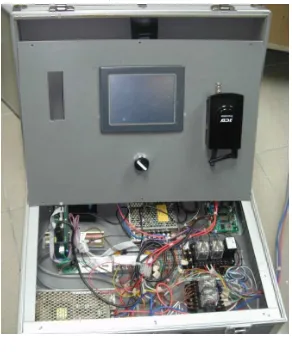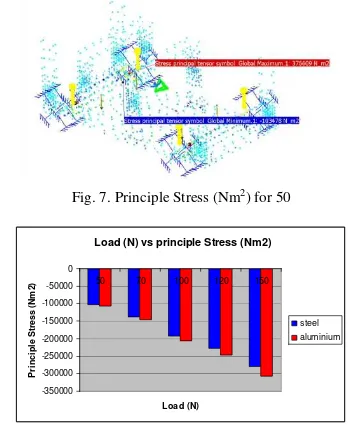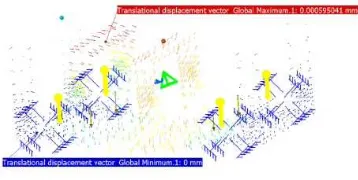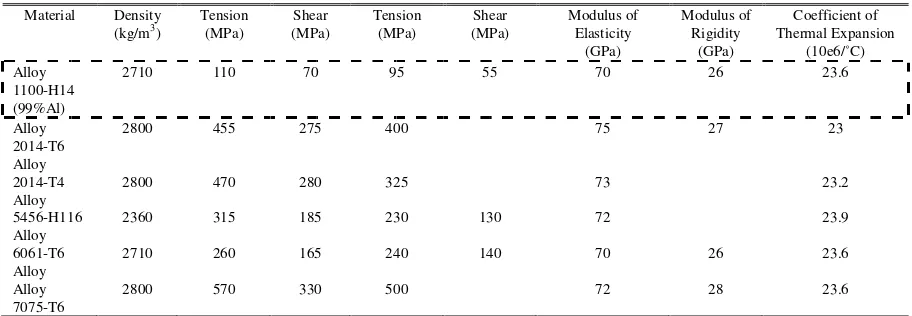Mechanical Structure Optimization of Sewerage Inspection Robot
Chee Fai Tan
1*, T. L. Lim
2, V. K. Kher
3Abstract –The sewerage inspection robot is a distance controllable robot by a human operator during the sewerage pipe inspection operation. It travel on wheels and is composed of mechanism like a mobile robot. The concept of this inspection robot is used to inspect the sewerage pipe that is not accessible and hazardous for human. The sewerage inspection robot will detect and inform the defect location for any maintenance and repair works. The common problems in the sewerage pipe are breakage, crack and obstacles between the connections. The developed sewerage inspection robot needs to be designed to withstand the collapse of the sewerage pipe so that the robot is fit to be used for next jobs. The project presents the mechanical structure optimization of sewerage inspection robot. The robot is solid rectangular shape and a designed for sewerage pipe. The paper also focused on the structural analysis of the developed robot. Copyright © 2009 Praise Worthy Prize S.r.l. - All rights reserved.
Keywords: Sewerage System, Inspection Robot, Mechanical Structure
I.
Introduction
For a city and town in Malaysia, the largest infrastructure investment is the sewerage system. Due to the high investment cost, the sewerage system needs to be maintaining well by inspection, maintenance as well as repair. The public sewerage system in Malaysia is more than 50,000 km long and it is a big challenge to maintain it. The most common sewerage pipe that used in Malaysia is about 200-900 mm inner diameter which is the focus for our research. Obviously, most of the systems are not accessible and hazardous to human. The current method to maintain such sewerage system is to use the telescopic camera to check the sewerage system. The telescopic camera is consists of a cable with energy supply, data transmission (distance and video) and as a lifeline. However, the current platform is restricted of its mobility due to radius constraint and complexity of design of the sewerage pipe line. The constraint is causing high inspection cost due to the frequent haul in and move to its next entry point. Moreover, the inspection area needs to be clear and shut down so that the inspection can be executed. Human were used to check the sewerage systems but only limited to the man-sized passable sewerage pipe. The usage of human inspection is dangerous, time consuming and expensive. Robot is an integration of mechanical, electrical and computer science that can use to perform the task in hazardous environment [6-9]. The inspection robot is used to gather additional information about the condition in the sewerage system access points. The inspection robot is low cost to manufacture, easy to maintain, customizable, operate continuously, record the condition of inspection area and waterproof. The sewerage inspection robot is beneficial to Malaysia building services, sanitary and HVAC industry. Mechanical structure analysis of the sewerage inspection robot is described in this paper.
II.
Sewerage System in Malaysia
Sewerage system is a place where the domestic waste and waste water from house and business premises to be collected and dispose off. In Malaysia, sewerage systems range from toilet, private treatment plants and public sewerage plants that manage and maintain by Indah Water Konsortium (IWK) [3]. In order to make sure all the underground pipe system works without a problem, these underground pipes had been designed into two section, a) Public pipe (under IWK) and b) Private pipe (individual responsibility). The IWK underground pipe is made on Vertical clay pipe (VCP) so it will more expose to the breakage [3].
III.
Sewerage Inspection Robot
CheeFai Tan, T. L. Lim, V. K. Kher
Copyright © 2012 Praise Worthy Prize S.r.l. - All rights reserved International Review of Mechanical Engineering, Vol.6, N. 7
IV.
Development of Sewerage Inspection
Robot
The sewerage inspection robot is designed to inspect and diagnose the sewerage system in Malaysia. Different technology such as mechanical, electrical, and electronic were integrated into the sewerage inspection robot.
IV.1. System Description
The sewerage inspection robot is a mobile robot that designed to inspect the sewerage system. The inspection operation is to gather additional information about what is taking place between sewer pipe access points. Human are used to check sewerage systems but only limited to the man-sized passable sewerage pipes. The usage of human inspection is hazardous, time consuming and expensive. The sewerage inspection robot is equipped with CCTV camera to view and recording the sewer systems. The robot can be controlled to move forward and backward as well as pan and tilt function to get better view of the inspected area. Fig. 1 shows the Sewer Pipe Inspection System.
Fig. 1. The sewerage pipe inspection system
IV.2. Hardware Architecture
Mechanical Design
Fig. 2 shows the model of the sewerage inspection robot. The unit is propelled by a gear type servo motor and it is a four wheel drive robot. The body is made from high quality stainless steel. The robot is sealed hermetically, both air tight and waterproof. The robot head is equipped by camera to record the HVAC conditions. A sensor unit is also attached with the robot to record the humidity level, temperature, air flow and indoor air quality.
Signal Processing
Components used within the signal processing group are programmable logic controller (PLC) and motor encoder. The PLC equipped with high speed counter where single phase: 4ch, total 10KHz. The counter range from -8,388,608 to +8,288,607. The PLC also equipped with
PID algorithm, I-PD algorithm, 10ms cycle to 10s cycle and have 16 loops.
Fig. 2. The sewerage inspection robot
Robot Console Unit
Fig. 3 shows the main robot console unit comprises of a touch screen control panel with necessary control button and switch. This console unit is to control the forward, reverse of the robot and the movement of the CCTV. In addition, the touch screens also displays the travel distance, humidity level, temperature, air flow and air quality from sensor unit.
Fig. 3. The main console unit
Sensor System
Camera Unit
The camera is the pan and tilt type, i.e. the camera lens rotate 360˚ around its axis and able to pan minimum 140˚ each side in order to inspect any damage at any location in an angle of minimum 90˚ ± 50˚. The speed of the camera in the robot is limited to 0.1 m/s for the duct diameter less than 200mm, 0.15m/s for diameter exceeding 200mm but not exceeding 310mm and 0.20m/s for diameters exceeding 310mm. Figure 6 shows the schematic of the camera unit.
Display Unit
The unit using the state-of-the-art wireless technology to transmit the visual data from the sewerage inspection robot to the console unit or else.
The system equipped with a wireless receiver, a digital video recorder (DVR) and 8” TFT monitor. The wireless receiver will receive the visual signal from main console unit. The visual signal will be recorded into the digital
V.
Mechanical Structure Analysis
The purpose of structural analysis is to find the critical part of the mobile robot structure when the load is applied. The CATIA analysis software is used to analyse the robot structure. The software is used to check the deflection and the stress (Von misses and maximum shear) when 5 kg to 15 kg of load being applied. The analysis software also has the ability simulate the deflections of the structure.
V.1. Von Misses Stress
The determination of distortion energy in a material of the energy associated with changes in shape in the material (the energy changes in volume in the same material). Fig. 4 show Von Misses in the structure. The Von Misses stress difference between both materials is high. Fig. 5 shows the minimum difference of Von Misses stress and Fig. 6 show the difference for maximum Von Misses stress.
Fig. 4. Von Misses stress for 50N
Load (N) vs Von mises Stress (Nm2)
0
Fig. 5. Load (N) vs. Von Misses stress for minimum value
Load (N) vs Von Mises Stress Nm2
0
Fig. 6. Load (N) vs. Von Misses stress for maximum value
V.2. Principal Stress
The brittle material can be easily fail due to the tension. The fact m > all indicated that | M | max is too large for cross section selected, but does not provide any information on the actual mechanism of failure. Similarly the fact m > all simply indicated that |V|max is too large for the cross section. While the danger for a ductile material is actually to fail in shear, the danger for brittle material is actually to fail in tension under the principle stresses (Fig. 7). The differential of principle stress between two materials is small. Fig. 8 shows the minimum differential for principle stress. At load 150N there is a high difference between these two materials for maximum principle stress (Fig. 9).
Fig. 7. Principle Stress (Nm2) for 50
Load (N) vs principle Stress (Nm2)
-350000
CheeFai Tan, T. L. Lim, V. K. Kher
Copyright © 2012 Praise Worthy Prize S.r.l. - All rights reserved International Review of Mechanical Engineering, Vol.6, N. 7
Load vs Principle stress (Nm2)
0
Fig. 9. Load (N) Vs Principle Stress (Nm2) for maximum value
V.3. Estimated Local Error
Local error (refer Fig. 10) is the section in the structure that most critical to fail when load was applied. This section need to improve depend how critical it is. The estimated local errors are different between these two materials. For minimum estimated local error there are a big different for both material. Fig. 11 shows the graph of differential for minimum. Fig. 12 shows estimated local error for maximum.
Fig. 10 . Estimated local error for 50
Load (N) vs Estimated Local Error (J)
0.00E+00
Fig. 11. Load (N) Estimated local error (J) for minimum
Load (N ) vs Estimeted Local Error (J)
0.00E+00
Fig. 12. Load (N) Estimated local error (J) for maximum
V.4. Translational Displacement
Displacement (referFig. 13) is a bending that occurs when the load was applied. Displacement is depending to the moment at each end. If the moment can against the load, the displacement is not occurring.
Fig. 13. Translation displacement for 50 (N)
As refer to Fig. 14, the displacement value between aluminium and steel. The steel value demonstrates the lower value than aluminum. Percentages of range between these two materials are 62% when 100 N was applied. Aluminum got the high value because the characteristic of yield strength is 55 MPa and value of yield strength for steel is about 145 MPa. But this result is still too small for displacement. Both materials (steel and aluminium) are good in displacement perspective from this analysis.
Load (N) vs Translations Displacement (mm)
0
Fig. 14. Load (N) Translation Displacement (mm) for maximum
V.5. Material
Table 1. The properties of aluminum part (local error), the reading for Alloy 1100-H14 (99%Al) equal to 9.01144e-17 J for steel structural (ASTM-A36) is equal to 1.56104e-16 J and for steel structural (ASTM-A36) the displacement is about 0.00108999 mm and for Alloy 1100-H14 (99%Al) 0.00289913 mm.
In this case the displacements reading for each material show a really small deflection occur and it can be conclude that all the material is suitable for this design. So another criterion to define the most suitable material is by knowing the advantages of the material.
VI.
Conclusion
The paper presents the structural analysis for the sewerage inspection robot. The robot meets all requirements regarding sensors, modularity and adaptation. The mechanical design of robot also meets the strength requirement by analyzed using the CATIA analysis software. From the experimental results, it is showed that Alloy 1100-H14 (99%Al) is the best material to use as the robot structure as compare to other materials. The sewerage inspection robot needs to design to resist the water and collapse of the sewerage system. The sewerage inspection robot can be used to replace the human for sewer system inspection and maintenance. The robot also equipped with various sensors system to check the sewerage conditions. Currently, the developed sewerage inspection robot is still under upgrading to enhance the capabilities and durability of the system.
Acknowledgements
The research work was funded by Universiti Teknikal Malaysia Melaka (UTeM) internal research funds (project no.: PJP/2005/FKM(13)/S00136). The author gratefully acknowledges the support of the Faculty of Mechanical Engineering (FKM) and Centre of Research and Innovation Management (CRIM) of Universiti Teknikal Malaysia Melaka (UTeM).
References
[1] S. Cordes, K. Berns, M. Eberl, W. Ilg and R. Suna, Autonomous Sewer Inspection with a Wheeled Multiarticulated Robot, Robotic and Autonomous Systems, Vol. 21, n. 1, pp. 123-135, 1997. [2] T. Fukuda and T. Mitsuoka, Pipeline Inspection and Maintenance
by Applications of Computer Data Processing and Robotic Technology, Computers in Industry, Vol. 7, n. 1, pp. 5-13, 1983. [3] Indah Water Konsortium, http:// www. iwk. com. my/
f-sewerage-fact.htm, accessed on 12 January 2012.
[4] E. Rome, J. Hertzberg, F. Kirchner, U. Licht and T. Christaller, Towards Autonomous Sewer Robots: the MAKRO Project, Urban Water, Vol. 1, n. 1, pp. 57-70, 1999.
[5] M.W. Siegel, W.M. Kaufman and C.J. Alberts, Mobile Robots for Difficult Measurements in Difficult Environments: Application to Aging Aircraft Inspection, Robotic and Autonomous Systems, Vol. 11, n. 3-4, pp. 187-194, 1993.
[6] T. Chettibi and P. Lemoine, Generation of Point to Point Trajectories for Robotic Manipulators under Electro-Mechanical Constraints, International Review of Mechanical Engineering, Vol. 1, n. 2, pp. 131-143, 2007.
[7] A. Cherfia and A. Zaatri, Workspace and Singularaties of a Constrained Parallel robot with 3 D.O.F. in Pure Transition, International Review of Mechanical Engineering, Vol. 1, n. 2, pp. 144-151, 2007.
[8] R. Mellah and R. Toumi, Adaptive Neuro-fuzzy control with Fast Learning Algorithm of PUMA A650 Robot Manipulator, International Review of Mechanical Engineering, Vol. 1, n. 4, pp. 347-355, 2007.
[9] I. Karabegovic, V. Dolecek and E. Husak, Analysis of the Industrial Robots in Various Production Processes in the World, International Review of Mechanical Engineering, Vol. 5, n. 7, pp. 1272-1277, 2011.
Authors’ information
1Integrated Design Research Group (IDeA), Faculty of Mechanical Engineering, Universiti Teknikal Malaysia Melaka,
Hang Tuag Jaya,
76100 Durian Tunggal, Melaka, Malaysia. Tel: +606-234 6710
Fax: +606 234 6884 Email: cheefai@utem.edu.my
2Intellogic Technology Private Limited, Malaysia.
3Integrated Design Research Group (IDeA), Faculty of Mechanical Engineering,
CheeFai Tan, T. L. Lim, V. K. Kher
Copyright © 2012 Praise Worthy Prize S.r.l. - All rights reserved International Review of Mechanical Engineering, Vol.6, N. 7
CheeFai Tan, PhD, graduated in Mechanical Engineering with honours, Master of Science in Manufacturing Systems Engineering from Universiti Putra Malaysia and PhD in Industrial Design Engineering from Eindhoven University of Technology, the Netherlands. He is a Senior Lecturer at Department of Design & Innovation, Faculty of Mechanical Engineering, Universiti Teknikal Malaysia Melaka since 2003. He actively involved in teaching and learning, consultation as well as research and development activities. His research interests cover the aspects of mechanical engineering design, industrial design engineering, smart system, multidisciplinary design and human-technology interaction design.
T.L. Lim, is a Director of Intellogic Technology Private Limited, Malaysia. He is an experienced machine designer as well as automation expert.



